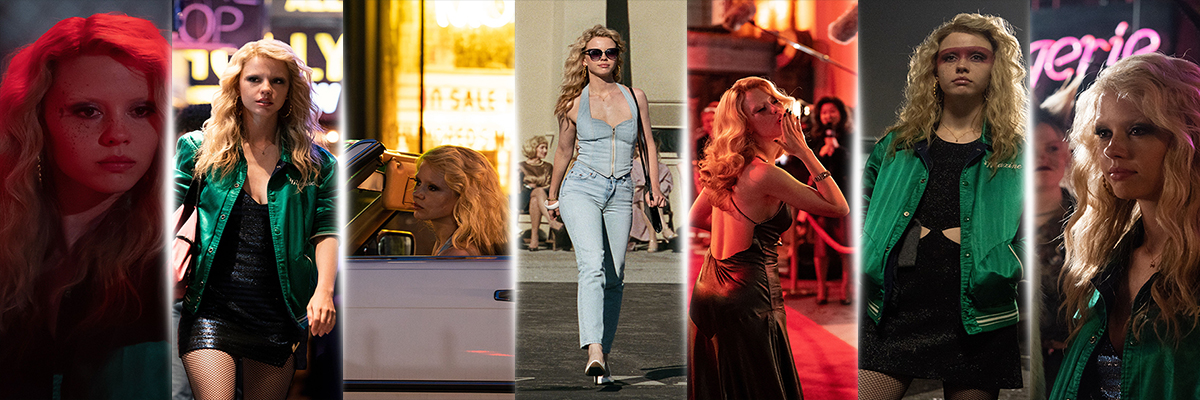
Movie Review – MaXXXine
The horror genre has always been a fascinating playground for filmmakers, often serving as a reflection of cultural anxieties, societal shifts, and personal fears. With the release of MaXXXine, the third and final film in Ti West’s X trilogy, the director once again demonstrates his mastery of suspense, atmospheric tension, and character development. Following X (2022) and Pearl (2022), MaXXXine brings the story full circle, intertwining the narrative threads of fame, ambition, and the quest for self-realization with the horrors lurking beneath. In this review, we will explore the film’s visual and thematic elements, the continuation of Maxine’s journey, its ties to the previous installments, and how MaXXXine further establishes West as one of the most exciting voices in modern horror cinema.
1. Background: The X Trilogy

To fully appreciate MaXXXine, one must understand its place within the trilogy and its thematic evolution. X introduced audiences to a group of filmmakers attempting to shoot an adult movie in rural Texas in the late 1970s, where things take a terrifying turn when they encounter an elderly couple harboring deadly secrets. The film was a loving homage to slasher films of the 1970s, complete with grainy aesthetics and brutal kills.
Pearl, a prequel to X, provided an in-depth exploration of one of the antagonists from the first film, the elderly woman Pearl. Set decades earlier, Pearl showcased her descent into madness, highlighting how the pressures of conformity and a deep-seated desire for fame can drive someone to the edge.
In MaXXXine, West shifts his focus to Maxine (played by Mia Goth), the final girl from X, as she seeks to carve out a career in 1980s Los Angeles. Maxine’s story is one of ambition and survival, set against the backdrop of an era defined by excess, glitz, and the darker side of Hollywood’s dream factory.
2. Plot Overview

MaXXXine picks up where X left off, following Maxine Minx as she moves to Los Angeles to pursue her dreams of stardom. Set in the mid-1980s, the film immerses itself in the neon-soaked world of the time, where the boundaries between art, entertainment, and exploitation blur. Maxine, fresh from surviving the horrors of Texas, is now determined to make a name for herself, but the road to success is fraught with peril.
In true Ti West fashion, the film intertwines horror and psychological drama as Maxine navigates the seedy underbelly of Hollywood. She encounters various characters – from sleazy producers and casting directors to fellow aspiring actors – all of whom represent different aspects of the industry’s predatory nature. As Maxine climbs the ranks, the film delves into themes of identity, morality, and the price one pays for fame. And, of course, there are the inevitable moments of horror, suspense, and bloodshed, as the film builds toward a shocking climax that ties back to the earlier films in the trilogy.
3. Thematic Exploration: Fame, Identity, and Exploitation

At its core, MaXXXine is a meditation on fame and the destructive forces that can come with the pursuit of it. In many ways, the film echoes the anxieties explored in films like Sunset Boulevard (1950) and Mulholland Drive (2001), where the pursuit of stardom leads to psychological unraveling and personal destruction. Maxine’s journey is no different, as she grapples with her own desires and the moral compromises she must make to succeed in an industry that commodifies people.
One of the most compelling aspects of the film is its exploration of identity. Throughout the trilogy, Maxine has been a character torn between her desire for fame and her sense of self. In X, she was introduced as an adult film actress seeking to break free from societal constraints and embrace her sexuality and individuality. In MaXXXine, we see the culmination of her character arc as she grapples with the loss of her former self in the face of fame. The film asks difficult questions about what it means to be authentic in a world that constantly demands performance, both on and off the screen.
The theme of exploitation also runs through the film, not only in terms of the horror elements but also in its critique of the entertainment industry. Hollywood has long been criticized for its predatory nature, particularly in how it treats women, and MaXXXine does not shy away from this. The film’s portrayal of casting couches, manipulative producers, and the pressures to conform to societal expectations all serve as commentary on the darker side of Hollywood’s glamorous facade.
4. Visual and Aesthetic Choices

Ti West’s ability to evoke a specific time and place is one of his greatest strengths as a filmmaker, and MaXXXine is no exception. The film is a visual feast, dripping with the excess and neon flair of 1980s Los Angeles. From the fashion to the music, the film immerses the audience in the era’s zeitgeist, capturing both its allure and its underlying darkness.
Cinematographer Eliot Rockett, who also worked on X and Pearl, returns for MaXXXine and delivers stunning visuals that blend gritty realism with stylized flourishes. The film’s color palette is dominated by neon blues, pinks, and purples, evoking the glitzy yet sleazy atmosphere of 1980s Hollywood. The city itself becomes a character in the film, representing both opportunity and danger for Maxine as she navigates its labyrinthine world.
In terms of horror, MaXXXine continues the trilogy’s tradition of practical effects and visceral violence. While the kills in the film are fewer than in X, each one is executed with precision and shock value, amplifying the tension as Maxine’s world spirals out of control. The film’s climactic sequence is a masterclass in suspense, building to a crescendo that is both horrifying and emotionally resonant.
5. Mia Goth: A Star Performance

It’s impossible to discuss MaXXXine without acknowledging Mia Goth’s powerhouse performance. Having already portrayed dual roles in X (as both Maxine and Pearl) and delivering a haunting turn in Pearl, Goth once again proves herself as one of the most exciting and versatile actors working today.
In MaXXXine, Goth brings a raw vulnerability to the character, balancing Maxine’s tough exterior with moments of introspection and doubt. As the character grapples with the pressures of fame and the moral compromises she faces, Goth’s performance becomes increasingly complex, culminating in a climactic scene that showcases her full range as an actor. It’s a performance that is both fearless and heartbreaking, solidifying Goth as the beating heart of the X trilogy.
6. Connections to X and Pearl

As the final chapter in the trilogy, MaXXXine is filled with references and callbacks to X and Pearl, both in terms of plot and thematic resonance. Maxine’s journey from aspiring adult film star to potential Hollywood starlet mirrors Pearl’s own desire for fame and recognition in the earlier films. Both characters are driven by a deep need to be seen and validated, and both are willing to go to extreme lengths to achieve their dreams. However, where Pearl’s journey ended in madness and violence, Maxine’s path is more ambiguous, leaving the audience to ponder whether she will ultimately triumph or fall victim to the same forces that consumed Pearl.
The film also continues the trilogy’s exploration of generational conflict, with Maxine representing a younger generation pushing back against the constraints imposed by society. In X, the elderly couple represented the dangers of nostalgia and the fear of aging, while in Pearl, the protagonist’s own mother embodied the oppressive expectations of women in a patriarchal society. In MaXXXine, the generational conflict takes on a new dimension, as Maxine must navigate an industry dominated by older, more powerful figures who seek to exploit her youth and ambition.
7. Soundtrack and Sound Design

A key element of MaXXXine’s immersive atmosphere is its use of music and sound design. The film’s soundtrack is a blend of 1980s synth-heavy tracks, which perfectly complement the film’s neon-soaked visuals and reinforce the era’s sense of excess. Composer Tyler Bates, who previously worked with West on Pearl, returns to create a score that balances tension and melancholy, heightening the film’s emotional beats and moments of horror.
In addition to the music, the film’s sound design plays a crucial role in building suspense. From the ambient sounds of the city to the unsettling creaks and groans of Maxine’s surroundings, the soundscape creates a sense of unease that permeates the entire film. This attention to detail in the sound design enhances the overall viewing experience, drawing the audience deeper into Maxine’s world.
For More : Visit our Web Stories
Alternative Movies Posters : Digital Download | Minimal Posters | Instant Download










